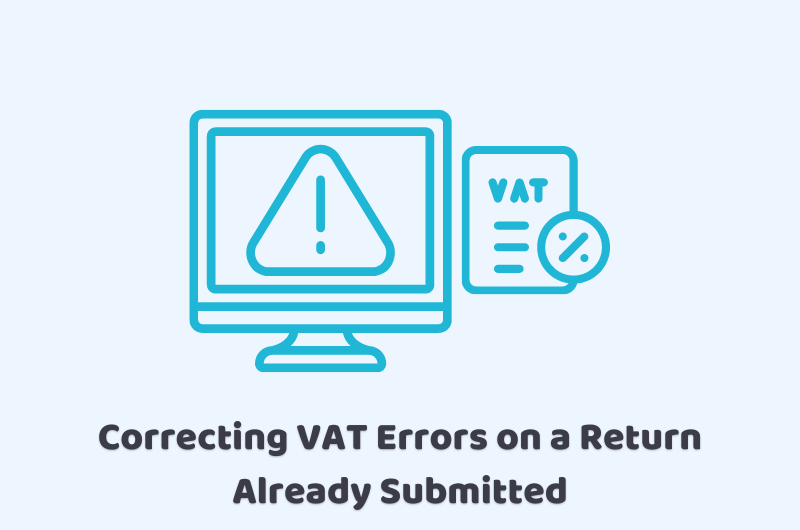
20/12/2022VAT
While you are in the middle of completing your VAT returns, it is quite possible that you can make an error with any form of accounting. This especially happens when you are carrying out a small business in the UK and handling everything on your own. Sometimes the occurrence of VAT errors is not due to your fault. In some cases, the invoice you receive from the supplier shows inaccurate details and you pay them with the expectation that your supplier will correct it. However, HMRC views it differently, and correcting VAT errors becomes your responsibility.
When a certain VAT error is not rectified by you on time, there is a list of penalties that HMRC can impose against you for not considering the VAT error seriously. This is normally known as the penalties for error regime. The good news is that the process of identifying and fixing VAT errors is quite straightforward. In this guide, you will gather information about how to deal with VAT errors. This involves the discussion of how to identify VAT errors, what to do when VAT errors are within the threshold, and how to adjust VAT errors.
Stuck with correcting VAT errors? Talk to our best accountants and bookkeepers in the UK at CruseBurke. You will get instant help whether you want to learn about the error regime or how to fix it.
Identify Before Correcting VAT Errors
When you are done making your business VAT registered, you are liable to submit VAT returns after every three months. In your VAT online account, you have the following basic details:
- The due date of your VAT returns.
- When should your payment be cleared in the account of HMRC?
Moreover, you have to be sure that while submitting your VAT returns, the rates and figures entered are accurate. Otherwise, this can put you in trouble and unfavourable circumstances. No one wants to deal with penalties and other punishments from HMRC. Sometimes, the mistake is identified after the submission of VAT returns. This can be due to errors in the calculations, false rates of VAT charged to any customer and omitting a receipt detail mistakenly.
The error can be identified in the latest submission or an old submission. However, this makes you responsible for identifying the error and taking immediate action after you realise it. If your mistakes are not identified by you but HMRC during an investigation, the penalties charged will be higher than normal.
What are VAT Errors within the Threshold?
If you are finding ways to keep the matter simple, what you can do is correct the errors on your next VAT return. This can be done without you having to report the mistakes to HMRC. This is only possible when your mistakes follow certain criteria that are outlined below:
- The figure is below a certain level of threshold.
- The error you have identified was not a deliberate error.
- The error you have identified belongs to the accounting period that is from the last years of your submission.
How to Adjust the Errors Outside of the Threshold?
Sometimes the value of errors falls outside of the threshold of HMRC. If you find out the mistake was older than the limit of four years or it was a deliberate mistake, you will have to report HMRC immediately. You can use the form VAT652 or the letter to inform HMRC and the VAT Error Correction Team. If HMRC witnesses a careless and deliberate mistake, you just be aware of the level of penalties you will be charged by them. Moreover, keep the following information before you plan to contact HMRC:
- The reason for error occurrence.
- The duration of the accounting period in which the error occurred.
- What is the amount of VAT error to be adjusted?
- What is your calculation to adjust?
- The amount of money you owe as a refund.
What are the Penalties by HMRC for Errors Regime?
Inaccuracies and mistakes are up for penalty by HMRC if they are found to be careless and deliberate mistakes. HMRC will expect you to take immediate action to fix the problem if you have found a non-careless mistake in the VAT returns. If you do not take immediate action to fix the problem, you will be charged a penalty from HMRC for showing non-serious behaviour and the mistake will be considered a careless or deliberate mistake. Moreover, if the errors are identified by HMRC during the investigation, they will be considered prompt. The errors are unprompted if you aim to disclose them to HMRC.
The Bottom Line
Now that you have gathered a fair amount of information about correcting VAT errors, we can bring the discussion towards wrapping up. There is no doubt that finding an error on the VAT return that is already submitted is complicated. However, you need to take immediate action and fix the error to keep yourself away from HMRC penalties. If you disclose the error to HMRC, the penalty will not be hefty. But if HMRC finds it out during an investigation, you will have to pay more than you expect in form of a penalty.
Are you seeking professional help to know about correcting VAT errors? Why not get help from the experts at the CruseBurke? Talk to us now!
Disclaimer: All the information provided in this article on correcting VAT errors includes all the texts and graphics. It does not intend to disregard any of the professional advice.

